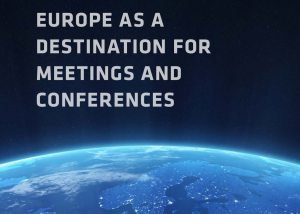MeetingMentor Magazine
Is Now Still a Good Time to Book a Meeting in Europe?
 Europe has long been a coveted destination for international association meetings — but between Brexit in the U.K., yellow-jacket demonstrations in France and Catalonia’s continuing bid for independence in Spain, uncertainty is rampant across the pond. Does this mean the European appeal is on the wane for international meetings?
Europe has long been a coveted destination for international association meetings — but between Brexit in the U.K., yellow-jacket demonstrations in France and Catalonia’s continuing bid for independence in Spain, uncertainty is rampant across the pond. Does this mean the European appeal is on the wane for international meetings?
Not necessarily, concludes a new white paper based on research conducted by nine members of the Strategic Alliance of the National Convention Bureaux of Europe and supported by the Professional Convention Management Association and Simpleview. But changing trends in economic, political, social and technological situations are affecting the meetings and events market in Europe — and many of those same trends could easily be extrapolated to other destinations as well.
Here is a breakdown of some of the challenges and opportunities explored in the study “Europe as a Destination for Meetings and Conferences.”
Uncertainty Does Not Inspire Confidence
Citing social, political and economic factors including Brexit, the social unrest in France and — for those doing business with the U.S. — concerns with how the Trump administration’s gyrations could affect future meetings, the paper said the “theme of uncertainty” was a part of every conversation researchers had with industry professionals.
The Brexit question remains a question right now, and whether a deal is reached on disconnecting the U.K. from the EU or not — and if so, what that deal entails — will determine what challenges organizers may face for future meetings in the U.K. That uncertainty, the report says, may drive some organizers to look at, and book, meetings on the Continent instead. Likewise, the highly visible yellow vest protests in France have resulted in a rise in meeting cancellations for French hotels, according to the report.
An added concern is the potential for another Eurozone economic slowdown now that global debt is 174 percent higher than it was just before the global financial crisis, and the EU gross domestic product appears to be faltering this year. On the bright side, this means U.S. organizers could find their dollars going further, making Europe more feasible for the budget-minded.
Interestingly, study participants did not appear to be terribly concerned with rising security threats. The mood for the moment, anyway, appears to be one of “Keep calm and carry on” following standard security practices. Should a terrorist attack occur, organizers are prepared to cancel, or to postpone their events so that they can “play a positive role in restoring stability and normalcy in the wake of a terror event” and still attract strong attendance numbers.
Diverse Destinations Keep European Countries on the Front Burner
Using data from the International Congress and Convention Association, the white paper points to an interesting conclusion: Countries that top the charts as European meeting destinations do not also top the rankings on a city level. For example, Germany leads the list of countries holding the most international meetings, yet only two German cities ranked in the top 25 European cities list.
“In essence, the key to regional dominance for any specific country is not having the highest number of top cities but one or two of the top cities, along with a much larger proportion of ‘lower tier’ cities that host fewer meetings each,” the report concludes.
Tech Trends Are Key
Five main tech trends are driving change in the meetings industry, both in Europe and worldwide. Hybrid meetings, where a percentage of the audience participates virtually, and fully online meetings are both on the rise, according to the report. Planners also are adding more digital elements to make their events more interactive and experiential. Of course, to keep all that digital connection humming, you need high-speed internet — and in fact, reliable, fast Wi-Fi was the No. 1 “must have” cited by planners. A key trend on the accessibility horizon are 5G networks, which are expected to up the speed and conductivity ante considerably as they begin to roll out this year and in 2020.
This boost in connectivity also is expected to boost meeting organizers’ ability to harness the power of the internet of things (IoT) for their events. Among the IoT innovations planners are looking forward to implementing are foot-traffic-mapping systems they can use to better optimize their show floors. In the meantime, look for more artificial intelligence to show up at meetings, especially in the form of chatbots that can endlessly answer those “Where is the nearest restroom?” types of questions.
Reducing the Event Environmental Footprint is Front of Mind
Among the general industry trends the report notes is the increasing importance of making meetings more environmentally friendly. As the report states, “This means that planners evaluate if physical meetings are actually necessary and attempt to consolidate them into fewer, larger events while moving others to online formats, in an effort to cut down on air travel. In addition, planners increasingly expect venues to enact more sustainable practices, making environmental sustainability a key criterion in their selection of partners.”
Download the full white paper (free registration required). — Sue Pelletier
Free Subscription to
MeetingMentor Online
"*" indicates required fields
About ConferenceDirect
About MeetingMentor